MORRIS LEO TAYLOR
WWII Experiences
Compiled 7-27-04
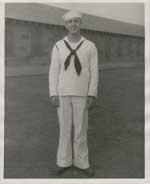 I
joined the navy in spring of 1942 and trained at Great Lakes Naval Center
outside of Chicago. Upon completion of basic training I attended
quartermaster school at Coddington Point, MA, near Newport, RI. While at
quartermaster school I became intrigued by the PT boats coming in and out of the
harbor from Melville, RI so after completing that school I volunteered for PT
boat duty and went right on to Melville for training on the PT.
I
joined the navy in spring of 1942 and trained at Great Lakes Naval Center
outside of Chicago. Upon completion of basic training I attended
quartermaster school at Coddington Point, MA, near Newport, RI. While at
quartermaster school I became intrigued by the PT boats coming in and out of the
harbor from Melville, RI so after completing that school I volunteered for PT
boat duty and went right on to Melville for training on the PT.
After PT boat training I was sent to New Orleans and assigned to a
Higgins PT
boat which, when commissioned, became the PT-230. From that point on the same
eight men and two officers remained together–quartermaster (me), a radioman,
three machinist mates, a torpedo man, a gunnersmate, and a cook. Later two more
gunnersmates, another torpedo man, and a radar man were added. We became very
close, and to this day those of us still around continue to get together as
often as possible either with other surviving PT boaters at the annual PT Boater
reunion or for other gatherings held around the country of just those of us who
have become especially good friends over the years. Our numbers are definitely
dwindling! We like to think of ourselves as “The Most Enthusiastic Group of
Veterans in the World”.
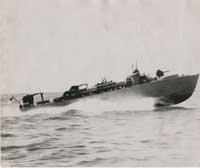 We
all trained on the guns, and it was said that the PT boats had the most
firepower per foot of any vessel in the Navy. In the beginning our
boat was fitted with two 20 millimeters plus two twin 50's in each of the two
turrets. Later we added a 40 millimeter on the stern and a 37 millimeter gun to
replace one of the 20 millimeters on the bow. Later still two 30 calibers were
mounted on the torpedo racks which replaced the bulky tubes that were just too
heavy. We carried four torpedoes at a time plus depth charges and smoke screens.
We
all trained on the guns, and it was said that the PT boats had the most
firepower per foot of any vessel in the Navy. In the beginning our
boat was fitted with two 20 millimeters plus two twin 50's in each of the two
turrets. Later we added a 40 millimeter on the stern and a 37 millimeter gun to
replace one of the 20 millimeters on the bow. Later still two 30 calibers were
mounted on the torpedo racks which replaced the bulky tubes that were just too
heavy. We carried four torpedoes at a time plus depth charges and smoke screens.
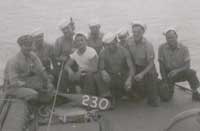 In
New Orleans Squadron 17 was formed with 10 boats (PT 225 to PT 234). We were
sent on a shakedown cruise from New Orleans to Tampa, Florida, then around the
Florida Keys to Miami where we engaged in additional training while awaiting
further assignment. From there we took the inland waterway to New York, still
under our own power, anticipating being assigned to relieve a squadron in Italy . We were surprised to see the New York bay just loaded with rubbers
(condoms) floating all over. New York at that time apparently was flushing
everything into the bay–what a sight!
In
New Orleans Squadron 17 was formed with 10 boats (PT 225 to PT 234). We were
sent on a shakedown cruise from New Orleans to Tampa, Florida, then around the
Florida Keys to Miami where we engaged in additional training while awaiting
further assignment. From there we took the inland waterway to New York, still
under our own power, anticipating being assigned to relieve a squadron in Italy . We were surprised to see the New York bay just loaded with rubbers
(condoms) floating all over. New York at that time apparently was flushing
everything into the bay–what a sight!
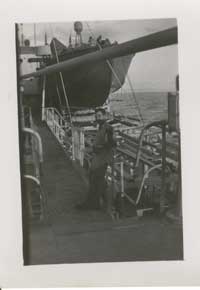 By
the time we got there Italy had been secured so we were reassigned to Panama to
work with the fleet in their training against Japanese suicide boats. We were
loaded onto freighters and tankers to make the trip, which
included stopovers in Guantanamo, Aruba, and other ports of call. From Panama
the PT boats in our squadron were loaded onto freighters and tankers again to go
through the Panama canal and up the coast of California to San Pedro where we
were once more reassigned, this time to the Aleutian Islands. As it turned out,
the Aleutians were secured before we left San Pedro, so we were then reassigned
to the South Pacific.
By
the time we got there Italy had been secured so we were reassigned to Panama to
work with the fleet in their training against Japanese suicide boats. We were
loaded onto freighters and tankers to make the trip, which
included stopovers in Guantanamo, Aruba, and other ports of call. From Panama
the PT boats in our squadron were loaded onto freighters and tankers again to go
through the Panama canal and up the coast of California to San Pedro where we
were once more reassigned, this time to the Aleutian Islands. As it turned out,
the Aleutians were secured before we left San Pedro, so we were then reassigned
to the South Pacific.
We were once more loaded onto freighters and tankers which took the squadron
to Hawaii to work with the fleet there and receive additional training at the
Pearl City Yacht Club. Some of the damage from the December 7, 1941 attack was
still evident. I saw the remains of so many of the sunken ships, including the
Arizona where the memorial to those who died on Pearl Harbor Day was later
built.
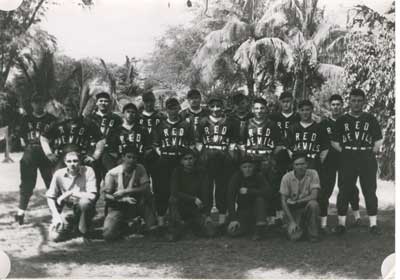
The Pearl City Yacht Club was where all PT boats were at that time awaiting
assignments, and many other ships were also in that area. While there we formed
baseball teams (ours was the Red Devils), played golf, and
generally were chomping at the bit to get out of there and see some action so we
could end this darn war. Some of these ball teams had “real” major and minor
league ball players who had enlisted, so more often than not the games were very
competitive and great fun to watch. See picture of our crew in Hawaii while
awaiting transfer to the South Pacific. I’m second from the right seated in the
front row.
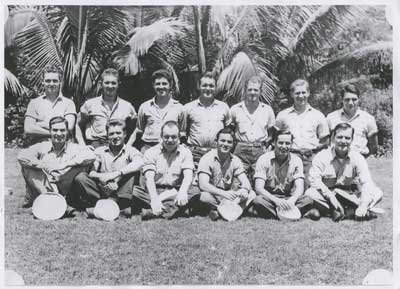
As an aside, after the war a member of our group was caught in a
tornado in MA and watched his baby ripped right out of his wife’s arms. The baby
didn’t survive, and because we were such a close-knit group we all felt his pain
when this happened.
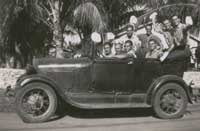 We
were in Hawaii for 10-11 months, then just our PT 230 and PT
227 were loaded onto a tanker which had room for only two boats. They selected
us because we were the considered the most ready. We had a hell of a crew and
our boat was always ready! Our skipper was strict and the exec who was the hull
officer kept the hull in great shape. He was a great one for shouting the
command, “Bring out the sheen!” We would sing while we worked to the tune of
“Bringing in the Sheaves” but changed the words to “Bringing out the sheen,
bringing out the sheen, we will work our balls off, bringing out the sheen!”
We
were in Hawaii for 10-11 months, then just our PT 230 and PT
227 were loaded onto a tanker which had room for only two boats. They selected
us because we were the considered the most ready. We had a hell of a crew and
our boat was always ready! Our skipper was strict and the exec who was the hull
officer kept the hull in great shape. He was a great one for shouting the
command, “Bring out the sheen!” We would sing while we worked to the tune of
“Bringing in the Sheaves” but changed the words to “Bringing out the sheen,
bringing out the sheen, we will work our balls off, bringing out the sheen!”
We were unloaded at Manus Island in the Marshall Islands, I think. It was
about the only place with the capability to unload our boats as they were
equipped with huge cranes. From there we sailed under our own power to Hollandia,
New Guinea, then to the Philippines .
We stayed around Manila Bay for quite awhile, and while there our crew traded
jeans, tee shirts, and other items to the natives for two fighting cocks so we
could compete in winner-take-all contests. As a result we accumulated enough
chickens for our cook to put together a terrific chicken, shrimp and spaghetti
dinner that I still remember–it was the best dinner we had the whole time we
were over there.
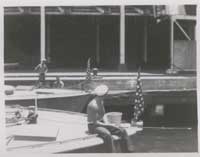 We finally became a part of an invasion task force to go into Mindoro,
and that battle became one of the turning points of the war because, once
secured, it provided an attack point and a PT base which supported the entire
landing. Different flags were displayed on the pier whenever we were docked .
We finally became a part of an invasion task force to go into Mindoro,
and that battle became one of the turning points of the war because, once
secured, it provided an attack point and a PT base which supported the entire
landing. Different flags were displayed on the pier whenever we were docked .
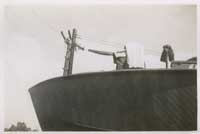 We
were expected to keep our uniforms clean and tidy so we often had to improvise
by hanging stuff on the guns to dry. The PT boats weren’t
equipped with showers but we were given special soap for use in salt water and
that worked. Sometimes if conditions were right we’d hop over the side for a
swim and good wash now and then. Fresh water was precious and used for drinking
and cooking only.
We
were expected to keep our uniforms clean and tidy so we often had to improvise
by hanging stuff on the guns to dry. The PT boats weren’t
equipped with showers but we were given special soap for use in salt water and
that worked. Sometimes if conditions were right we’d hop over the side for a
swim and good wash now and then. Fresh water was precious and used for drinking
and cooking only.
We saw a lot of action on patrol, and one time a 20 millimeter shell came
right through the bulkhead, sliced through a 20# coffee can and the inner
bulkhead of the latrine, and ended up rolling back and forth on the deck of the
crew’s quarters without exploding. I found it and without giving it a thought I
picked it up and tossed it over the side. It was only afterward that it dawned
on me how lucky I was that it hadn’t exploded in my hand.
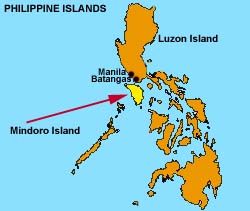 We were attached to an armada sent to establish the PT boat base at Mindoro
and quickly learned to stay out of the way. At one point, we watched a Kamikaze
come in and hit a cruiser command tower, creating many casualties. I don’t think
any of us felt really scared because when we signed up for PT boat duty we never
figured we’d come back alive anyway. Those destroyers didn’t give a shit about
us little guys; they just seemed to think we should get our butts out of the way
when the fleet was under attack. We speculated that was what happened to
Kennedy’s PT 109–it probably didn’t move fast enough to avoid being hit by one
of our destroyers while it was shooting at the Kamikazes coming into the fleet.
The PT boats were just expected to watch out for the destroyers, and not the
other way around.
We were attached to an armada sent to establish the PT boat base at Mindoro
and quickly learned to stay out of the way. At one point, we watched a Kamikaze
come in and hit a cruiser command tower, creating many casualties. I don’t think
any of us felt really scared because when we signed up for PT boat duty we never
figured we’d come back alive anyway. Those destroyers didn’t give a shit about
us little guys; they just seemed to think we should get our butts out of the way
when the fleet was under attack. We speculated that was what happened to
Kennedy’s PT 109–it probably didn’t move fast enough to avoid being hit by one
of our destroyers while it was shooting at the Kamikazes coming into the fleet.
The PT boats were just expected to watch out for the destroyers, and not the
other way around.
 LST’s carrying equipment and such came later to establish the base and it was
then we really came under attack. The Kamikazes were attacking the PT’s, the
LST’s, and everything else. We watched them blow up a PT right next to our boat,
not more than 15' away, but the closest they came to us was when we had our
exterior latrine that was attached to the stern damaged by a zero wing tip that
cracked one of the supports.
LST’s carrying equipment and such came later to establish the base and it was
then we really came under attack. The Kamikazes were attacking the PT’s, the
LST’s, and everything else. We watched them blow up a PT right next to our boat,
not more than 15' away, but the closest they came to us was when we had our
exterior latrine that was attached to the stern damaged by a zero wing tip that
cracked one of the supports. Fortunately nobody was in there at the time because
we were all at general quarters--I was in my combat station at one of the twin
50 caliber guns returning enemy fire at the time. A day or two later we saw two
planes, a Jap zero and a Marine Corsair, come right toward us and crash,
probably as much from our fire as from the rest but we couldn’t tell for sure
which guns got them. We didn’t stay at the dock during those days because it was
just too darn dangerous.
Fortunately nobody was in there at the time because
we were all at general quarters--I was in my combat station at one of the twin
50 caliber guns returning enemy fire at the time. A day or two later we saw two
planes, a Jap zero and a Marine Corsair, come right toward us and crash,
probably as much from our fire as from the rest but we couldn’t tell for sure
which guns got them. We didn’t stay at the dock during those days because it was
just too darn dangerous.
During the lull after one attack we were on board the LST’s to take the
wounded away, sometimes on cots and often just in our arms. I remember one I
carried out was a commander who had been hit and very badly wounded. His
shoulder was crushed and just hanging there. I never knew what happened to him
after that, if he lived or died, but always wondered. Another day we were going
ashore and pulled a torso out of the water; it was one of our men from the PT
that got blown up right next to us. All together we were under attack for 21
days with very little sleep. We lived off of what we called horse cock (bologna)
and coffee. See the commendation from the Secretary of the Navy for additional
details of those first days at Mindoro. No wonder the PT boats were quickly
pegged as the “Japanese Nemesis.”

 We made our patrols and once I remember we watched a dog fight between a P-38
and a Jap Zero. Finally one of them hit the silk but one of the other boats
picked the pilot up so we never knew if it was the American or the Jap. On
another patrol our mission was to go out and try to find survivors of two boats
that had been blown up the night before while on patrol. We had a Philippino on
board and some of us spotted a raft with a starfish lying on the bottom. The
Philippino said the men were on shore, and he knew that because the raft had to
have been on shore for the starfish to be on it. So we headed toward shore and
all of a sudden we saw these men walking out from the beach in single file to be
sure they were in the right place to be picked up and we were the “good guys”
and not the enemy. We picked up around 15 to 17 of the original crew between us
and two other boats.
We made our patrols and once I remember we watched a dog fight between a P-38
and a Jap Zero. Finally one of them hit the silk but one of the other boats
picked the pilot up so we never knew if it was the American or the Jap. On
another patrol our mission was to go out and try to find survivors of two boats
that had been blown up the night before while on patrol. We had a Philippino on
board and some of us spotted a raft with a starfish lying on the bottom. The
Philippino said the men were on shore, and he knew that because the raft had to
have been on shore for the starfish to be on it. So we headed toward shore and
all of a sudden we saw these men walking out from the beach in single file to be
sure they were in the right place to be picked up and we were the “good guys”
and not the enemy. We picked up around 15 to 17 of the original crew between us
and two other boats.
Another incident was when we were sent to pick up two Japanese suicide boats
that had been captured by ground forces. It was our mission to tow them back to
base. In checking them we found they had Dodge motors made in Detroit, MI to
power them. How those Dodge motors got into the Japanese boats we’ll never know.
Unfortunately, the sea got a little heavy and we lost both boats so ended up
with no boats and of course a reprimand.
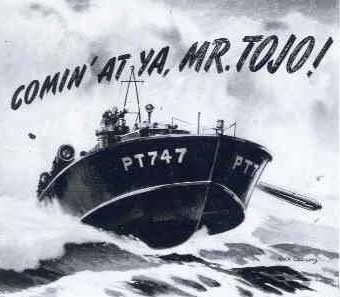
Censorship was something you just lived with when serving overseas during
WWII. Even when we had film developed we ran into the censor problem (see
both
sides of the Theater Censor slip collected when I had some film developed). In
those days photography wasn’t as foolproof as it is today, but we did fairly
well bringing back some decent little pictures to spark the memory as time goes
by. I don’t go through my box of odds and ends from the PT boat days too often,
but find it an intriguing thing to do now and then.
One of the sad moments of our time over there was when we got word that our
squadron commanding officer had been relieved, and on his way home his plane was
shot down--there were no survivors. He was just a prince of a man.
We were all supposed to get R & R in Australia sometime while we were
stationed in the South Pacific, but there just was never a good time. So in 2001
I finally made a trip there. It seemed only right to get to Australia sometime
before I died.
When the war ended arrangements were made to ship us to California on a Limey
(English) troop ship. More time was spent on board that ship than we ever
expected; in excess of three weeks as I recall. The thing I remember in
particular was that we ate an awful lot of mutton. We cut the center of the
bread, which was baked as a 6" cube, and formed it into a ball and used it to
play catch. Somehow they never could figure out how to bake the bread clear
through. We played a lot of poker, soaked up the sun, read what we could get our
hands on, and thought about how nice it was going to be to be home at last.
The final piece is a news story about the Battle of Mindoro which includes a
map of the region. It was an incredible experience and worth the effort which we
thought would bring peace to the world and ensure freedom to fellow Americans
for all time. I still pray for peace on earth and good will to men. I’m proud to
have been a part of WWII and look forward to seeing the WWII Memorial in
Washington, DC in September.
 I
joined the navy in spring of 1942 and trained at Great Lakes Naval Center
outside of Chicago. Upon completion of basic training I attended
quartermaster school at Coddington Point, MA, near Newport, RI. While at
quartermaster school I became intrigued by the PT boats coming in and out of the
harbor from Melville, RI so after completing that school I volunteered for PT
boat duty and went right on to Melville for training on the PT.
I
joined the navy in spring of 1942 and trained at Great Lakes Naval Center
outside of Chicago. Upon completion of basic training I attended
quartermaster school at Coddington Point, MA, near Newport, RI. While at
quartermaster school I became intrigued by the PT boats coming in and out of the
harbor from Melville, RI so after completing that school I volunteered for PT
boat duty and went right on to Melville for training on the PT. 







 We were attached to an armada sent to establish the PT boat base at Mindoro
and quickly learned to stay out of the way. At one point, we watched a Kamikaze
come in and hit a cruiser command tower, creating many casualties. I don’t think
any of us felt really scared because when we signed up for PT boat duty we never
figured we’d come back alive anyway. Those destroyers didn’t give a shit about
us little guys; they just seemed to think we should get our butts out of the way
when the fleet was under attack. We speculated that was what happened to
Kennedy’s PT 109–it probably didn’t move fast enough to avoid being hit by one
of our destroyers while it was shooting at the Kamikazes coming into the fleet.
The PT boats were just expected to watch out for the destroyers, and not the
other way around.
We were attached to an armada sent to establish the PT boat base at Mindoro
and quickly learned to stay out of the way. At one point, we watched a Kamikaze
come in and hit a cruiser command tower, creating many casualties. I don’t think
any of us felt really scared because when we signed up for PT boat duty we never
figured we’d come back alive anyway. Those destroyers didn’t give a shit about
us little guys; they just seemed to think we should get our butts out of the way
when the fleet was under attack. We speculated that was what happened to
Kennedy’s PT 109–it probably didn’t move fast enough to avoid being hit by one
of our destroyers while it was shooting at the Kamikazes coming into the fleet.
The PT boats were just expected to watch out for the destroyers, and not the
other way around.
 Fortunately nobody was in there at the time because
we were all at general quarters--I was in my combat station at one of the twin
50 caliber guns returning enemy fire at the time. A day or two later we saw two
planes, a Jap zero and a Marine Corsair, come right toward us and crash,
probably as much from our fire as from the rest but we couldn’t tell for sure
which guns got them. We didn’t stay at the dock during those days because it was
just too darn dangerous.
Fortunately nobody was in there at the time because
we were all at general quarters--I was in my combat station at one of the twin
50 caliber guns returning enemy fire at the time. A day or two later we saw two
planes, a Jap zero and a Marine Corsair, come right toward us and crash,
probably as much from our fire as from the rest but we couldn’t tell for sure
which guns got them. We didn’t stay at the dock during those days because it was
just too darn dangerous.
